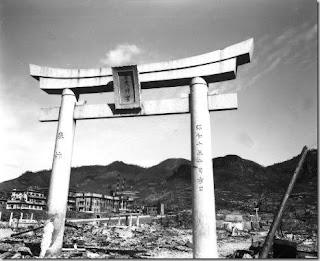I was inspired to post on this today as I read a chapter in a book that explained the tori gate with information I did not know. The tori is the gate that one passes through when entering a "Shinto" shrine. It is symbolic of Japan. Its primary function as I said is to mark the boundary to the shrine.
The tori gate also speaks in silence to those who pass under it, you are entering and now inside a sacred place and you shall behave accordingly. Traditionally that means to be quiet and behave reverently at all times.
If you visit Japan and take in one of its many attractions, a shinto shrine, it behooves you to find out the etiquette and follow it. Be on guard and diligently remain aware of the unspoken rules to keep within the countries etiquette and customs - remain respectful.
Also, you will note that the tori gate also has, often, two stone statues of Korean dogs that guard one side and the other of the entrance. They are slightly asymmetrical, one with its mouth open, and the other closed. I don't know the significance of that part.
I am not totally sure if the tori gates are used elsewhere in Japan and/or in Okinawa. I wonder if they are used at either countries dojo entrances. I can understand if they are used that it might signify that one is entering a place they consider sacred in that a serious endeavor is taken on when you enter the dojo and that it marks the boundary of the dojo. It would also fit that when entering you must be quiet and respectful at all times, etiquette being what it is in Japan and Okinawa - of varying degrees and customary traits.
I am not sure if it is appropriate if used at dojo but I suspect it is not exactly what they are meant for when added to certificates and other such stuff. I did try my best to find information as to its usage beyond the Shinto Shrine entrance with no luck, maybe one of my readers can shed light on this. It does bring to mind that in my practice I might take a moment to consider this before using one for some purpose other than Shinto related respect for Shinto shrines. What is the etiquette for tori gates or rather what is the shikata for tori gate usage?
I did find someone's statement that said, "As I understand it the Asian tori gate represent a entrance to a sacred area, leaving the outside world and entering another... very fitting for MA." In our perception of the dojo and the act of "mokuso" it is a belief that one must leave all their outside world concerns at that point and are entering into an area of concentrated effort and study which is derived from Buddhist, Shinto and Zen origins - maybe.
 |
| Tori Gate to Meji Shrine Japan, click for larger view. |
Note: It is a theory that since karate training is also performed at shrines and burial places that they naturally created the same environment with the torii gates, etc.
This one is remarkable as it is the only object that remains after either the Hiroshima or Nagasaki atomic bombing that ended world war II.







